Bed Bug Bites: Causes, Symptoms, Treatment & More!
By Dr. Vishesh Bharucha +2 more

Get,

to manage your symptom
Get your,


4 Cr+ families
benefitted

OTP sent to 9988776655



You’ve successfully subscribed to receive
doctor-approved tips on
Whatsapp

Get ready to feel your best.

Hi There,
Download the PharmEasy App now!!


Register to Avail the Offer
Send OTPBy continuing, you agree with our Privacy Policy and Terms and Conditions

Hi There,
Sign up on PharmEasy now!!
Trusted by 4 crore+ families

OTP sent to 9988776655



You have unlocked 25% off on medicines




Code: NU25
By Dr. Vishesh Bharucha +2 more
Table of Contents
Bed bug bites happen when reddish, tiny, and flat insects, called bed bugs, come out at night and feed on your blood while you are sleeping. This can cause skin irritation, make you scratch, and disturb your sleep1.
Bed bug bites are becoming a growing problem worldwide. Although the rates of bed bug infestation had declined by the late nineties, their population has shown a resurgence in the recent past owing to factors like travel, immigration and development of resistant strains. They are costly to remove, requiring a lot of money to get the homes cleaned and replace the infested items. They also impact health, as their bites may cause allergies, skin problems, and stress2.
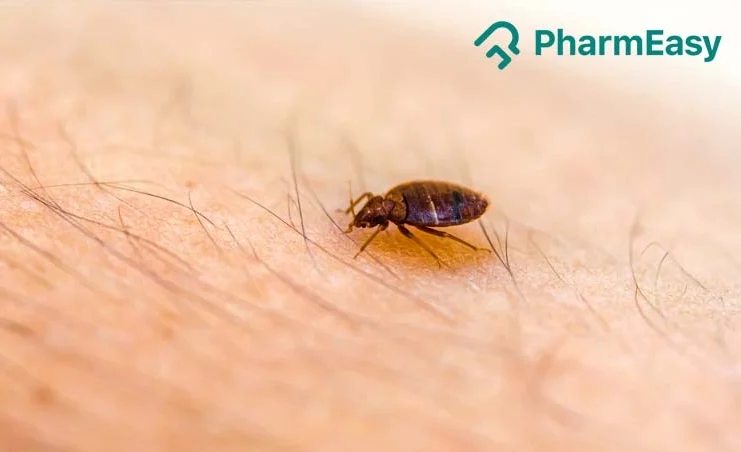
In this blog, let’s take a detailed look at bed bug bites, their causes, symptoms, treatment, and how to get rid of bed bugs.
Bed bugs are blood-sucking insects. They belong to the Cimicidae family and are now found almost everywhere in the world.
These bed bugs feed only on blood. The babies are called nymphs. Nymphs grow by shedding their hard outer skin called an exoskeleton. Each nymph needs to bite and drink blood to grow into the next stage. After going through five stages, they become adults.
Adult bed bugs also need regular blood meals to have babies. At comfortable room temperatures (around 72°F), it usually takes about 5 weeks (37 days) for an egg to grow into an adult. The exact time can change depending on warmth and how much blood is available. Most adult bed bugs live 3 to 10 months, but if conditions are very good, some may survive almost a year. They can also survive for several months without feeding in cooler places3,4.
Now that we know what bed bugs are and how they grow, let’s look at the types of bed bugs found around the world.
There are different kinds of bed bugs. Scientists say there are up to 90 species, but only about three species commonly feed on humans. The two main types of bed bugs that affect humans are Cimex lectularius, the common bed bug, and Cimex hemipterus, the tropical bed bug. Occasionally, Leptocimex boueti can bite humans in parts of West Africa3,5.
The common bed bug is found worldwide, including parts of Asia, Europe, the Americas, and Madagascar. The tropical bed bug is mostly found in hot and humid areas near the equator, and also other areas including Middle East, northern Australia, the United States, Russia, and Europe.
Recently, both types of bed bugs have started appearing outside their normal regions.
This happened because of more travel, migration, the use of second-hand items, and resistance to insect sprays. These bed bugs have reached new areas, and now both types can sometimes be found in the same regions2,3.
Next, let’s see what they look like, where they bite, and how they appear.
Bed bugs are real bugs with a special needle-like mouth for sucking blood3. Adult bed bugs are about the size of an apple seed (5–7 mm) and are brown and flat if they have not eaten recently. After feeding, they become reddish-brown and round like tiny balloons. They have tiny golden hair, and a slightly musty-sweet smell from glands may be noticed when there are many bugs.
Baby bed bugs, called nymphs, are very small and see-through or pale yellow. They are hard to see if they have not eaten recently because of their tiny size and light colour. Bed bug eggs are tiny, about the size of a pinhead, and are pearl-white in colour. As the embryo develops, a small dark spot may appear inside the egg2,6.
Bed bug bites look like small red marks or tiny bumps on the skin. Sometimes they appear in a line or cluster, often called the “breakfast, lunch, dinner” pattern. Bites usually appear on exposed skin while sleeping, such as the face, neck, arms, and hands. Some people may not show visible bites at all. This happens because bed bugs use their tiny, needle-like mouths to pierce the skin and drink blood. Their saliva can stop blood from clotting and has other proteins, which can make the bites itchy and red. Sometimes, a little blood may be seen on sheets3,7.
Next, we will see where bed bugs commonly live.
Bed bugs can live and stay active in cool temperatures as low as 7°C (46°F), but they cannot survive if their body temperature reaches 45°C (113°F). When they are not feeding, bed bugs hide in small cracks and spaces. They often stay in mattress seams, box springs, bed frames, or headboards. In heavily infested rooms, they can be in sofa seams, cushions, curtains, drawers, electrical outlets, behind wallpaper, at wall corners, and even in tiny gaps around screws. Any space as small as a credit card can be a hiding spot.
Bed bugs are more common in crowded places like apartments, hotels, or areas with lower income3,8. They do not live on humans or travel on skin like lice or fleas, but they can be carried passively on clothing, bags, or belongings during the day9. They are mainly active at night and are attracted to carbon dioxide, body heat, and human scent. They can spread from one home to another through vents, outlets, used furniture, luggage, or bags4,8.
Bed bug bites can cause different reactions in different people, and some may not notice any effect, especially the first time they are bitten. The common bed bug bites symptoms are:
Rarely, larger bumps, over 6 cm may be present, which is usually due to a severe allergic reaction or secondary infection3,7.
Bed bug bites can sometimes cause other health problems, especially when the bites are severe or happen repeatedly, which includes:
In the next section, we will learn how to distinguish bed bug bites from other insect bites.
Bed bug bites may look different from other insect bites in their size, pattern, and where they appear on the body. Sometimes bed bug bites may not show any noticeable signs, while others appear as small, red, raised bumps about 5mm in size, though in sensitive people they may swell up to around 1 cm. They are often seen on the face, neck, arms, or any exposed skin3,7.
The main feature that differentiates bed bug bites from other insect bites is their pattern. As mentioned, bed bug bites often appear in lines or clusters of three or more, called the “breakfast, lunch, and dinner” pattern. This occurs when a bed bug moves slightly to find a larger blood vessel or is disturbed while feeding. However, they may also appear scattered, making them hard to tell apart from other insect bites3.
Other insect bites appear differently:
The main differences are the pattern, size, and location of the bites. Bed bug bites usually form lines or clusters, but sometimes appear scattered, while most other insect bites appear singly or randomly3,11.
Anyone can be affected by bed bug bites, regardless of age or gender. However, some groups face a higher risk. People who travel frequently, especially those staying in hotels or guest houses, are more likely to carry bed bugs. Individuals living in crowded places such as apartments, hostels, or dormitories are also commonly affected, as bed bugs spread easily in shared spaces. Bed bugs can also spread when people share beds, rooms, or use second-hand furniture, clothes, or bags. They cannot jump or fly; instead, they hide in tiny spaces and move with the belongings people carry1,3.
Bed bug bites can be diagnosed first by confirming the presence of the insects. This can be done by looking for any signs of infestation at home, such as:
Bed bugs can travel 5–20 feet on average from where they hide, though some can crawl up to 100 feet to reach a host and feed on blood1.
For more severe skin reactions or larger lesions, doctor consultation may be needed. While asking questions, the doctor may want to know if the bites show up after waking, if the person has recently travelled or stayed in hotels, or if second-hand furniture or clothes were bought. They will check for the typical linear/cluster “breakfast-lunch-dinner” lesions, major allergic reactions or any signs of infection. Not everyone reacts the same way, only about 7 out of 10 people show skin changes. Children and older adults may react less often, but in children, when reactions do occur, the swelling and redness can sometimes be more noticeable5.
Therefore, while bite patterns and history give important clues, a confirmed diagnosis of bed bugs requires finding evidence of the insect itself.
Usually, the bed bug bites tend to improve and sometimes disappear without treatment. If there is no sign of infection or if it is not severe, bed bug bite treatment includes simple steps like:
However, if the bites are scratched repeatedly, if fluid appears in the bumps, or if there are swollen, leaking, or severe allergic reactions (red, swollen skin or hives), consulting a skin specialist would be recommended. For bed bug bite treatment, the doctor may advise the following based on your condition:
While these steps help manage the bites, the next focus is on how to get rid of the bed bugs themselves.
There are several effective methods to remove bed bugs. Each technique works differently and may be used alone or in combination for better results.
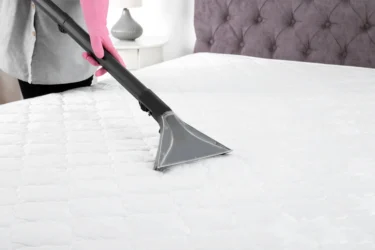
Vacuuming can help clear bed bugs from hiding spots like mattresses, carpets, and cracks. While vacuuming cannot remove all the eggs as they stick firmly, it can collect live bugs, skins, and droppings. The vacuum bag should then be sealed and thrown outside the house.
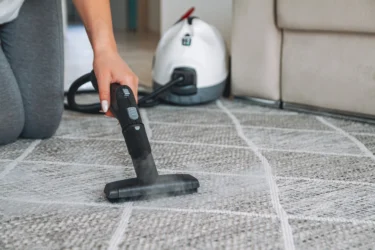
Bed bugs die when exposed to high heat. Steamers can be used on mattresses, couches, carpets, and other furniture where insecticides cannot be applied. Steam must reach about 114-115°F as heat transfer through steam is rapid and works directly on contact. It should be slowly passed over all surfaces to make sure bugs and eggs are destroyed fully.
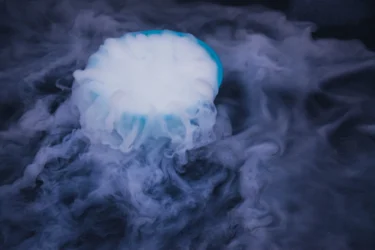
Some pest control companies use carbon dioxide snow at very low temperatures (around -108°F) to freeze bed bugs instantly. The gas can penetrate through cracks, furniture, and bedding, killing the bugs.

This natural powder kills bed bugs by damaging their protective outer layer, causing them to dry out and die. Only insecticide-grade diatomaceous earth should be used, as pool-grade is harmful to breathe.
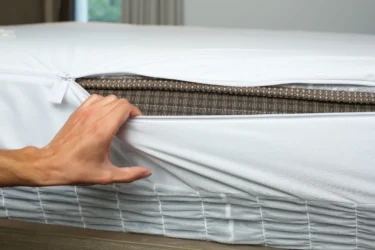
Special bed bug-proof covers are available for mattresses and box springs. These covers prevent bugs from entering or escaping, and the trapped bugs will die eventually. The encasement must be zipped tightly to work.
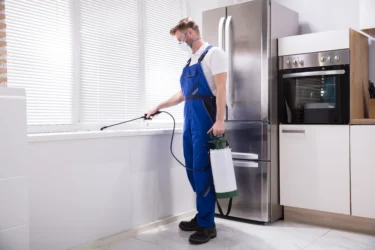
Pest control teams may also use heating systems to raise room temperature to 120–135°F. To work properly, this heat must stay at the same level for a few hours and spread evenly everywhere. This kills all bed bugs and eggs in just one session. Heat can reach cracks, furniture, and other hard-to-access areas, killing both bed bugs and their eggs, without damaging belongings4,15,16.
These methods help in removing bed bugs, but it is also important to mainly avoid them in the first place. Let us now see how to prevent bed bugs from infesting.
Preventing bed bugs is important, and these preventive tips are believed to help avoid bed bugs from infesting your home, which include:
By following these simple tips, bed bugs can be reduced and controlled, even though they cannot always be fully prevented.
Bed bug bites are uncomfortable and can cause itching, irritation, and disturbed sleep, but they do not spread disease. Detecting an infestation early, caring for bites properly, and seeking professional pest control helps manage the issue. Regular cleaning, inspecting belongings, and reducing clutter can also lower the risk of bed bug infestation.
Bed bug bites most commonly appear on the exposed parts of the body while sleeping. This includes the face, neck, arms, and hands, but they can also occur on any skin not covered by clothing or bedding during sleep1.
Bed bugs die instantly using specific methods. Steam works by applying high heat slowly over surfaces like mattresses, couches, and carpets to destroy bugs and eggs. Pressurised carbon dioxide snow freezes bed bugs instantly at -108°F. Professional heating systems can raise room temperature to 135°F, killing bed bugs immediately4.
Bed bugs basically do not live in hair. They feed on exposed areas of the skin such as the face, neck, arms, and hands, avoiding hair. They usually prefer hairless areas. When not feeding, they hide near mattress seams, piping, tags, and cracks in the bed frame or headboard1,19.
Bed bugs can live on pillows, especially around seams and tags. They usually hide in these spots, as well as near mattress and box spring seams, and in cracks in the bed frame and headboard1,20.
No, sleeping with the light on will not stop bed bugs. They usually prefer dark places, but they will still come out to feed when a host is present21.
Bed bugs can be drawn out of hiding by using traps like dry ice traps and sugar-yeast traps which release CO₂. A bed bug gets attracted to CO₂, thinking a host is nearby, bringing them out of hiding. Along with CO₂, even warmth and host-like scents can attract them22.
Disclaimer: The information provided here is for educational/awareness purposes only and is not intended to be a substitute for medical treatment by a healthcare professional and should not be relied upon to diagnose or treat any medical condition. The reader should consult a registered medical practitioner to determine the appropriateness of the information and before consuming any medication. PharmEasy does not provide any guarantee or warranty (express or implied) regarding the accuracy, adequacy, completeness, legality, reliability or usefulness of the information; and disclaims any liability arising thereof.
Links and product recommendations in the information provided here are advertisements of third-party products available on the website. PharmEasy does not make any representation on the accuracy or suitability of such products/services. Advertisements do not influence the editorial decisions or content. The information in this blog is subject to change without notice. The authors and administrators reserve the right to modify, add, or remove content without notification. It is your responsibility to review this disclaimer regularly for any changes.
Comments

Leave your comment...
You may also like
Comments